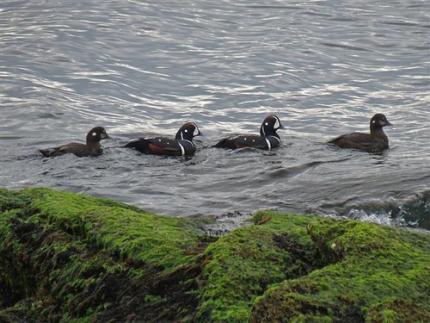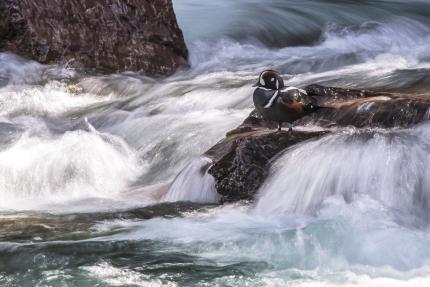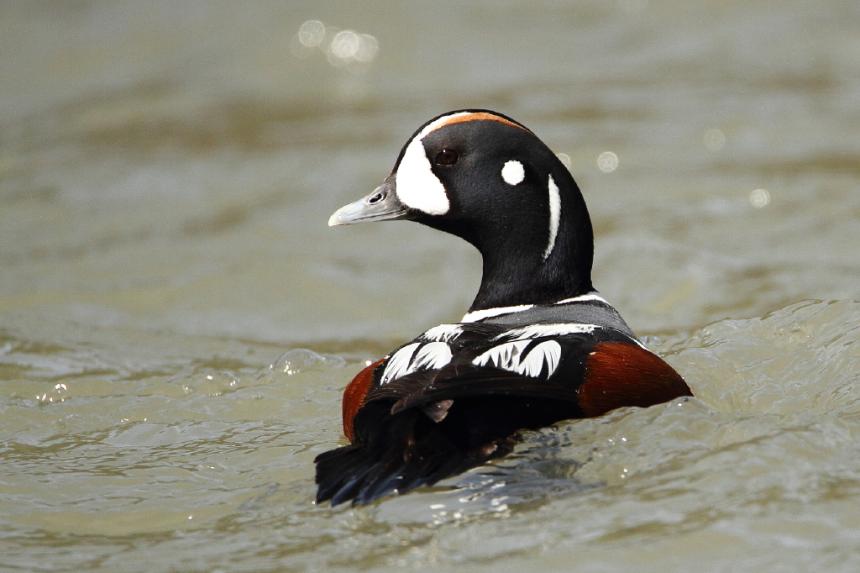Moderate-
High
This sea duck species has low population numbers in Washington. Declines in wintering numbers of harlequin ducks have occurred on Puget Sound. Conservation concerns include the effects of human disturbance, degradation of coastal habitats, pollutant discharge and reduction of marine forage.
Harlequin duck is managed as a migratory game bird. Sea ducks are managed under state and federal migratory waterfowl regulations cooperatively through the Pacific Flyway Council.
Description and Range
Physical description

The harlequin duck is a small sea duck measuring about 17 inches in length and weighing about 1 ½ pounds. The adult male (“drake”) has glossy slate-blue plumage enlivened by white stripes and spots, giving it a striking appearance. The female (“hen”) resembles a small female scoter. At a distance, both sexes look black.
The flight of harlequin duck is swift, with abrupt turns. This species' flocks are small and compact.
For more information on how to identify this species, check out the Sea Duck Joint Venture "Meet the Sea Ducks."Also check out the Resources section.
Ecology and life history
The harlequin duck is found on fast-flowing streams in riparian, subalpine, and coastal habitats during the breeding season.
Similar to other sea duck species, annual recruitment for this species is low due to delayed maturity, variable breeding propensity, small clutch size, relatively low numbers of successful breeders, and other factors related to productivity and brood survival. Natural events, particularly flooding, have the potential to negatively impact prey populations (such as caddisfly larvae), which have been associated with decreased reproductive efforts for harlequin ducks. WDFW surveys documented an average of approximately 10 percent young in the winter population during 2008 to 2010.

Breeding males and subadults move to the coast to molt during June and July, with females and broods arriving during August-September. These same molting areas are important wintering areas for harlequin ducks from several western states and provinces. Adult harlequin ducks exhibit a substantial degree of faithfulness to wintering areas.
Geographic range
The harlequin duck’s range is on both coasts, north from New Jersey and San Francisco.
Surveys in 1996 documented approximately 400 breeding pairs of harlequin duck on Washington streams, primarily in the Cascade and Olympic mountain ranges. An average of approximately 3,000 harlequins wintered on Puget Sound during 2012 to 2014, a reduction of 15 percent since 1994 to 1996.
For maps of range-wide distribution and other species’ information, check out NatureServe Explorer and the International Union for Conservation of Nature Red List.
Climate vulnerability
Sensitivity to climate change
Moderate-
High
The overall sensitivity of this species is likely moderate-high due to habitat (i.e., inland freshwater areas for breeding and coastal areas for wintering) and forage (i.e., aquatic invertebrates, herring spawn) specialization. Breeding habitats and success as well as forage could be altered by flood events, while changes in temperature and pH could affect availability of key forage species. Additionally, earlier snowmelt can result in phenological mismatch with harlequin duck breeding ecology.
Exposure to climate change
Moderate-
High
- Changes in precipitation (timing and amount)
- Earlier snowmelt
- Increased flood events
- Increased water temperatures
- Declines in pH
Regulations
Rules and seasons
For current rules about hunting harlequin duck in the state, be sure to check the Washington Game Bird and Small Game hunting regulations.
Conservation
Sea ducks are game species, managed under state and federal migratory waterfowl regulations cooperatively through the Pacific Flyway Council. The Pacific Flyway Council is an administrative body that forges cooperation among public wildlife agencies for the purpose of protecting and conserving migratory birds in western North America. The Council is composed of the director or an appointee from the public wildlife agency in each state and province in the western United States, Canada, and Mexico. Washington waterfowl hunters pursuing sea ducks in western Washington are required to record and report all harvest effort and activities, including for harlequin duck.
WDFW has various game management plans to track populations and harvest of games species around the state, including waterfowl. These plans have information about harvest statistics from recent years, and the department's long-term vision and goals for a variety of species.
In early 2003, WDFW formed the Washington Waterfowl Advisory Group (WAG) to increase citizen involvement in the conservation and management of Washington’s waterfowl resources. This group has members from a broad representation of waterfowl hunters throughout the state. To learn about the WAG, contact the WDFW Waterfowl Section at (360) 902-2515 or visit the WAG webpage.
Conservation Threats and Actions Needed
- Resource information collection needs
- Threat: Lack of range-wide delineation of Puget sound winter population.
- Action Needed: Develop satellite telemetry study to document use areas.
- Threat: Lack of information on population demography.
- Action Needed: Conduct periodic recruitment surveys.
- Fish and wildlife habitat loss or degradation.
- Threat: Development impacts of Puget Sound on breeding and wintering habitat.
- Action Needed: Research/surveys to document and address limiting factors.
See the Climate vulnerability section for information about the threats posed by climate change to this species.
Our Conservation Efforts
Midwinter Aerial Seabird Surveys
WDFW conducts survey flights over a period of several days from November through February annually to monitor the abundance, trends, and distribution of sea ducks and other marine birds in the Puget Sound and the Strait of Juan de Fuca (U.S. portion of the Salish Sea). Learn more about this research on the project's page.
Resources
References
Pacific Harlequin Duck Management: Recommendations for Rocky Mountain-Northwest Coast Segment. July 23, 2004. Pacific Flyway Study Comm. [c/o USFWS], Portland, OR.
WDFW publications
PHS Program
Other resources
- U.S. Fish and Wildlife Service - Overview: Harlequin Duck
- U.S. Fish and Wildlife Service - Aerial Observer’s Guide to North American Waterfowl
- U.S. Fish and Wildlife Service - Ducks at a Distance: A Waterfowl Identification Guide
- Sea Duck Joint Venture - A Conservation Partnership under the North American Waterfowl Management Plan
- Cornell Lab All About Birds - Harlequin Duck
- eBird Northwest - Harlequin Duck



